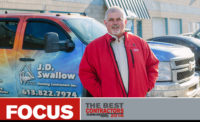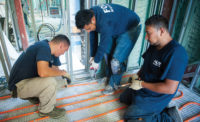CHICAGO — No longer is radiant considered only an expensive niche heating or cooling option for savvy consumers. Rather, as energy costs continue to increase year after year, radiant heating and radiant cooling is becoming commonplace, especially in commercial installations. A number of radiant products were on display at the 2015 AHR Expo in Chicago.
Energy, Cost Savings
At the AHR Expo, Rehau introduced a snow and ice-melting (SIM) system with smart controls to efficiently eliminate snow and ice buildup from outdoor surfaces by circulating a heat transfer fluid through Rehau PEXa pipes installed within the SIM area, increasing surface safety while lowering maintenance costs and minimizing environmental impact. The Rehau Smart Controls SIM Module senses everything from slab temperature and snow/ice to boiler supply and return fluid temperatures while also analyzing the weather forecast. When the control anticipates a storm, it can automatically warm the surface in advance of snow or ice.
Watts Radiant, a Watts Water Technologies company, introduced the Custom TapeMat, a pre-shaped mat providing electric floor warming. The Custom TapeMat features an open weave design that allows for a one-step application with thin-set or safe-leveler, and its double-sided tape adheres to subflooring for faster layouts. It’s also simple to adjust for curves, angles, and cutouts.
Superior Radiant Products Inc.’s MODULUS™ Adaptive Modulating Infrared Tube Heater, part of Series AM, adapts to the environment, providing optimal thermal comfort. The Series AM combines the benefits of a fully modulating infrared heater with SRP’s 100 percent efficient reflector for maximum efficiency. The MODULUS fully modulates gas and air, provides fully automatic or manual control of burner modulation, and is self-regulating with no fixed points.
Commercial Market
“Through a number of successful case studies, we see radiant cooling becoming a very well-accepted system for high-performance buildings,” said Devin Abellon, business development manager, engineering services for Uponor. “As contractors become more familiar with how to install radiant systems, we see the cost involved coming down, as well.”
That familiarity has already largely been achieved in Europe, where radiant cooling is a common and popular option, but the path toward acceptance on a large scale in the U.S. has been an uphill climb for the radiant portion of the HVAC industry.
Rehau also showcased the RAUMAT Radiant Heating Mat System. The system is RAUPEX O? Barrier pipe preassembled onto mats that are rolled out on the job site to speed installation. RAUMAT is intended for radiant heating and is designed for commercial building projects with large open-slab areas such as distribution centers, big-box stores, and production halls. RAUMAT is customized to each project for exact mat-and-tail configurations and delivered ready to roll out on the job site.
“Commercially, we are seeing a big trend in radiant cooling, heating, and snow-melting,” said Lino Santoro, director of radiant sales, Viega LLC. “Radiant options are becoming widely accepted and radiant cooling is being utilized due to energy codes. Radiant cooling’s return on investment has increased to a good point.”
Multifaceted Solutions
Abellon’s views on the rise of radiant cooling were largely shared by Ric Turmel, iWorX regional sales manager, Taco Electronic Solutions.
“Combining radiant heating and cooling is becoming very popular,” said Turmel. “Whether we are talking about radiant slats or panels, commercially chilled beam systems are becoming popular too. Beams do both heating and cooling, so the name is a misnomer, but that is one of the things coming to the forefront. It’s an extremely energy-efficient type of system. Over time, we will see it used more and more as people learn how to use the chilled beam system.”
At the AHR Expo, Taco Inc. showcased expansions to its iWorX control platform and its updated graphical user experience. A PC, tablet, or smartphone can now act as a local control interface for monitoring, system diagnostics, and new graphics within the platform. Touch-screen control, Wi-Fi connections, and ready automatic updates via the app provide additional ease of use. For building owners, this means custom integration with dramatically reduced installed cost, greater system intelligence, and continuous monitoring and control of system performance and energy management for the life of the building.
“As the interest in radiant systems grows, we are seeing many new products and innovations being offered to improve system performance and make installations easier,” said Abellon. “Another trend we are seeing is in the areas where radiant systems are being applied. Radiant floor-cooling systems can be very effective in areas such as lobbies and atria with high, direct solar-heat gains. So, we’ve seen numerous applications where radiant cooling is used specifically for these types of spaces. What we are seeing more and more of, however, is the use of radiant cooling systems, not just for these special areas, but as the primary means of cooling to serve the entire building.”
Uponor launched a stainless steel manifold targeted for residential and commercial radiant heating and cooling applications. Made of corrosion-resistant stainless steel, the manifold is available in 1- and 1 ¼-inch sizes in 2- through 8-, 10-, and 12-loop configurations. It features integrated flow meters for easy system balancing, full-port ball valves with temperature gauges, and balancing and isolation valves for complete loop isolation. Preassembled, the manifold provides contractors with faster installs and also offers greater material cost savings.
“Adding the stainless steel manifold to our radiant manifold offering allows us to provide our customers with a cost-effective, preassembled metal alternative,” said Mark Hudoba, director, heating and cooling at Uponor. “Now, professionals can choose from our comprehensive offering of stainless steel, engineered polymer (EP), or TruFLOW™ brass manifolds to meet any radiant application need.”
“When you start to look at the evolution of heating applications, primarily, you have seen a lot of hot-air equipment that has been utilized in a commercial space for a lot of good reasons,” said Mark Parent, director of product management, Viega LLC. “Things like Title 24 are starting to drive efficiency requirements, which has led to an increase in system integration. No longer are you looking at apples and oranges in terms of different kinds of systems. We are finding ways to blend those systems.
“Through the needs of engineers, we are driving education and knowledge, and are centering on how to integrate systems. The big question becomes control strategy and how to do the integration and manipulate different aspects of the system.”
Publication date: 2/23/2015
Want more HVAC industry news and information? Join The NEWS on Facebook, Twitter, and LinkedIn today!











